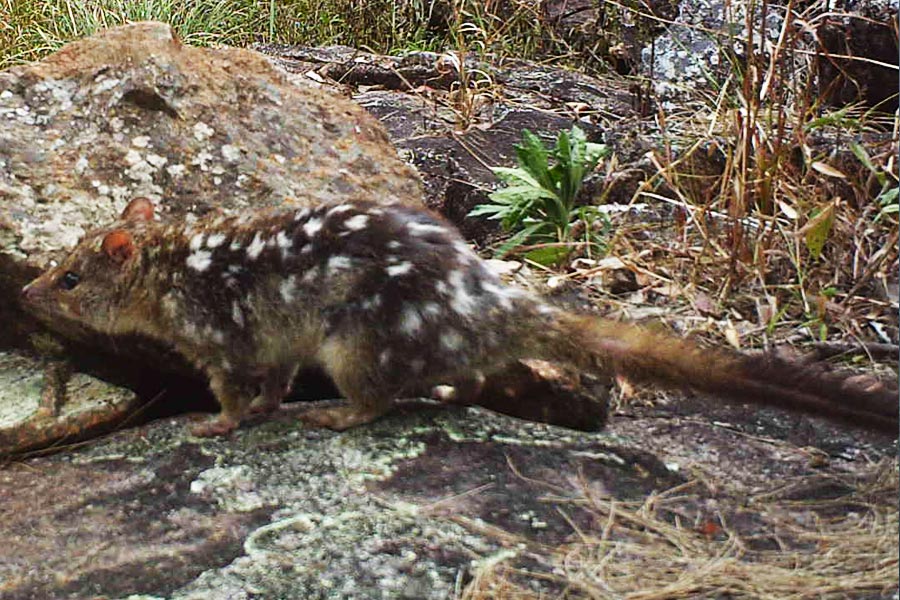Status and species overview
The Northern quoll, a primarily carnivorous marsupial, is the smallest of the four Australian quoll species. Primarily nocturnal, they inhabit a diverse range of woodlands, beaches and creek lines in northern Australia and do not have highly specific habitat requirements. However their range has contracted significantly since the arrival of Europeans, with the species remaining in isolated populations across the northern part of the continent.
Unusually, male Northern quolls die after mating and rarely live for more than a year leaving the females alone to raise their young. Females too, often die after breeding with only thirty percent surviving to reproduce in a second year. Female quolls may live for two or three years and only produce one or two litters in a lifetime.
Northern quolls have been recorded locally in the following areas
- Crediton SF
- Midge Point
- Proserpine River
- Peter Faust Dam
- Dryander
- Cannonvale
- Finch Hatton
- St. Helens Creek
- Cathu SF
- Bucasia
- Kelsey Creek
- Goorganga Plains
- Dingo Beach
- Cape Upstart
- Cape Gloucester
Fire regimes specific to maintaining northern quoll habitat have been recommended for the Mackay and surrounding Whitsunday region.
Land managers are encouraged to burn in the early dry or storm season and to utilise cool fires that are more likely to retain hollow logs and stags used by quolls. Retaining unburnt patches also ensures the availability of shelter for protection from predators and maintains habitat for prey species. The burning of small areas (100-500 ha only) in a single burn is encouraged, with 50% mosaic. Land managers should avoid burning during the dry season when young are born as this limits their chance of survival to adulthood. Northern Quoll Fire Management
Description
The northern quoll, the size of a cat, is brown to greyish-brown with white spots. It has a cream to white belly and a tail with sparse fur.
They feed primarily on insects, but may occasionally feed on small mammals, birds, snakes, lizards and frogs but will also consume fruit, including figs. northern quolls will change their diets according to season and food availability.
Habitat features utilised by the northern quoll vary and may include hollow logs, tree hollows, rocky areas, human dwellings and termite mounds. However of these, rocky areas including (in Queensland) sites with large boulders have been identified as retaining the most abundant remnant populations. These areas provide a fire-sheltered habitat and offer reduced risk from common predators, such as cats, who are limited in their ability to forage. Rocky areas also retain water for longer periods and support a higher diversity of microhabitats, providing the quoll with a greater range and availability of food sources.
Researchers are attempting to teach captive northern quolls not to eat Cane Toads. With no physiological resistance to the poisonous toads, northern quolls have disappeared from many parts of their range since cane toads reached these areas. Skinned cane toad meat, with poisonous parts removed, was mixed with a nausea-inducing chemical, stuffed back into the toad leg skin and fed to the quolls making them feel ill. Repeated attempts to feed cane toad to the quolls resulted in some of them refusing to eat the toad meat. It is hoped that quolls that refuse cane toads will be released into the wild and teach their young to avoid the toxic toads and dine instead on more palatable species.
Conservation concerns
Known threats include:
- Ingestion of cane toad toxin
- Predation by feral cats and foxes and competition with the latter
- Habitat alteration and destruction through altered fire regimes, land clearing, mining, improved pastures and grazing
What can I do?
- Control cane toads on your property
- Ensure cats are kept indoors
- Maintain suitable grazing regimes to reduce the impact of cattle on quoll habitat (maintain low stocking rates to maintain ground cover)
- Implement suitable fire regimes to maintain Northern quoll habitat
Further Information
- National Recovery Plan for the Northern Quoll
- EHP Queensland Quolls
- ALA
- Clarke Conners Range Fire Management Guidelines
Photo credit Tina Ball
